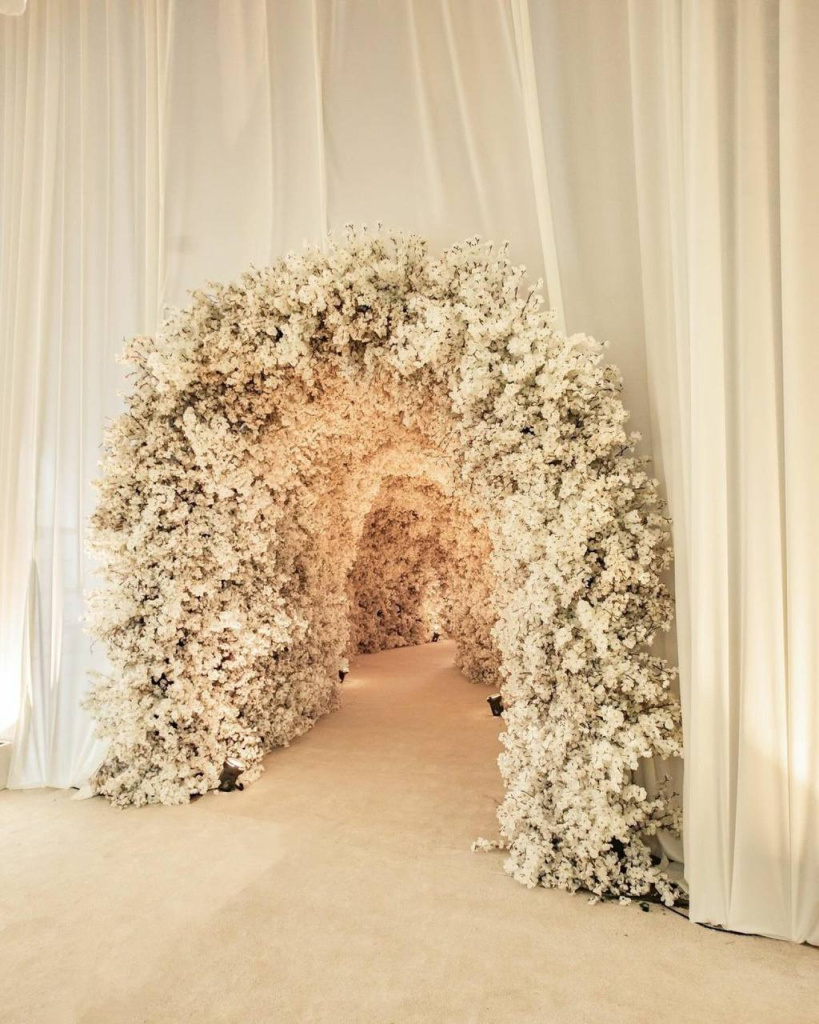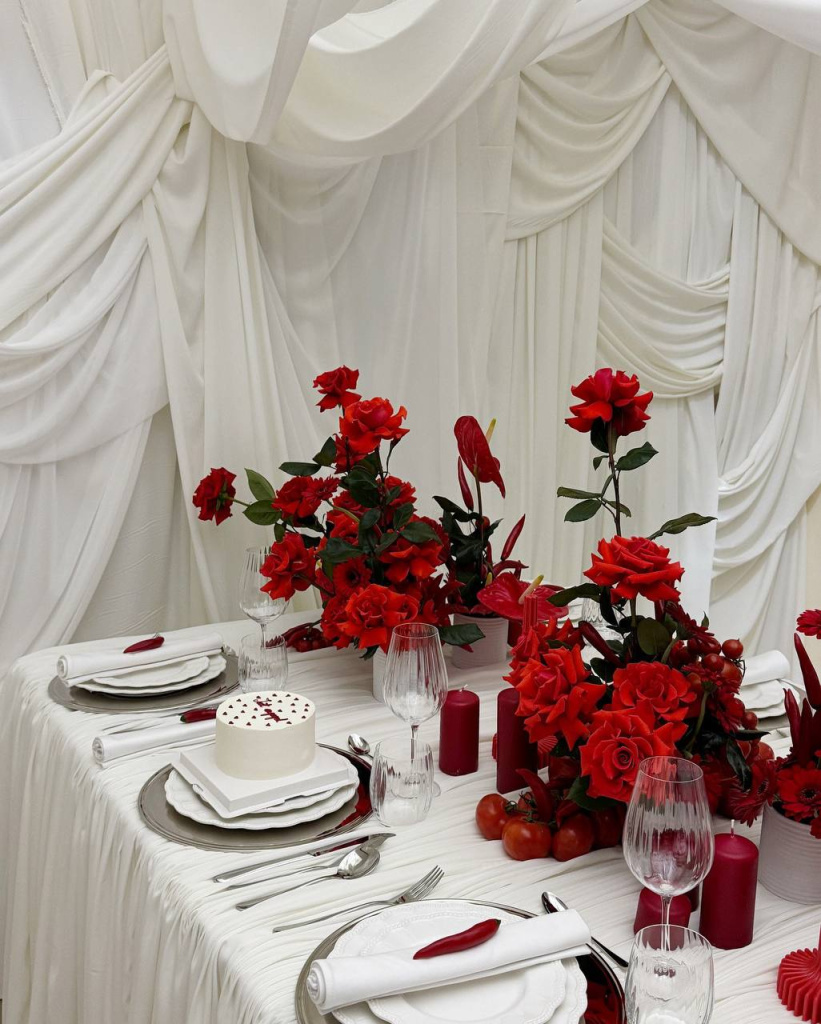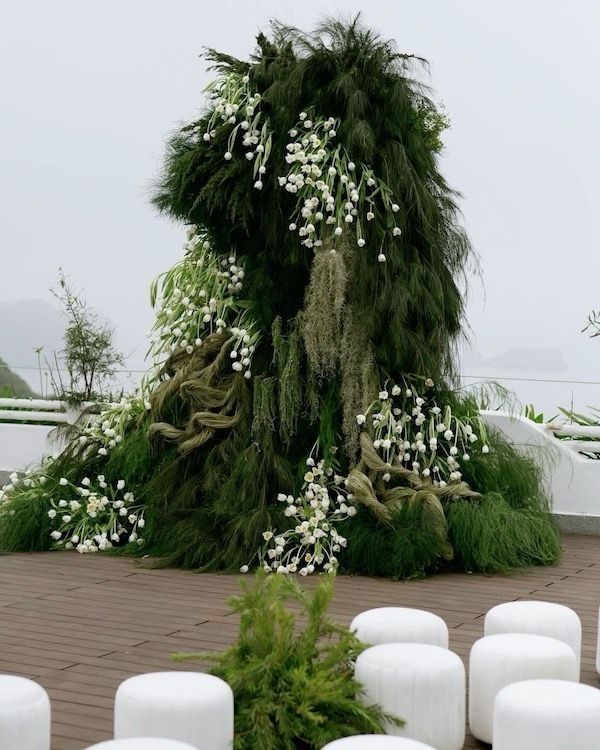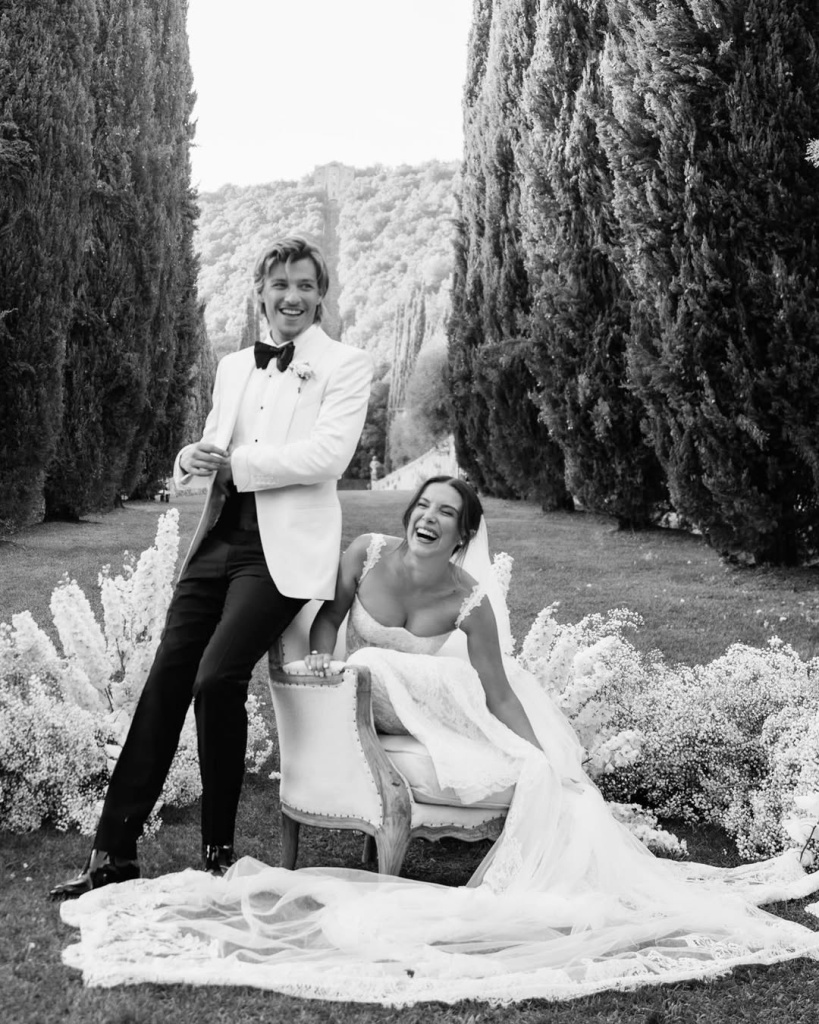Floral Design Trends for 2025
- Author: Natali Grace Levine
- Reading time: 10 min 49 sec
- Publication date: 12/16/2024
- Updated: 09/02/2025
Imagine walking down an aisle adorned with the most enchanting flowers, each petal and leaf whispering tales of love and commitment. As we look ahead to 2025, the canvas of wedding florals is vibrant with colors and textures that promise to turn your special day into a breathtaking masterpiece. From the charm of sustainably sourced blooms to the dramatic flair of artistic installations, here are the top 2025 floral trends that are set to captivate hearts and beautify ceremonies in the most extraordinary ways. Whether you're dreaming of a grand celebration or a quaint intimate gathering, these trends will help you weave a floral fantasy that mirrors your deepest desires and shared stories.



Sustainable Sourcing
As couples become more environmentally conscious, sustainable sourcing of wedding florals is not just a trend but a heartfelt commitment to the planet. In 2025, this approach is all about minimizing environmental impact while maximizing aesthetic appeal. By choosing locally sourced blooms, couples reduce transportation emissions and support local economies, making their special day beneficial for their community and the earth alike.
Here are a few ways to embrace sustainable sourcing in your wedding floral arrangements:
- Opt for flowers grown by local farmers or through community-supported agriculture programs. Not only are these flowers fresher, but they also promote biodiversity and sustainable farming practices.
- Choose flowers that are in season at the time of your wedding. Seasonal flowers require less energy to grow and maintain, and they'll look naturally beautiful because they're at their peak.
- Incorporate wildflowers and native plants which are adapted to your local environment. These plants usually require less water and care, and they help support local wildlife.
- Partner with florists who share your values on sustainability. These professionals often use organic methods, avoid harmful chemicals, and prioritize ecological balance.
- Plan to repurpose your flowers throughout the wedding events, and consider donating them to hospitals, nursing homes, or shelters after the event to spread joy and reduce waste.
- Ask your florist about using biodegradable or recyclable materials for arrangements and avoid floral foam, which is non-biodegradable and contains toxic elements.
Dried and Preserved Florals
Dried and preserved florals have carved a niche in the wedding scene, celebrated for their longevity and versatility. In 2025, these everlasting blooms are not just practical; they're a stylistic choice that brings warmth and a touch of whimsy to any celebration. Preserved flowers undergo special treatment to maintain their color and form, making them perfect for weddings in any season.
Dried flowers, on the other hand, offer a rustic and earthy vibe that can be both romantic and nostalgic. These floral choices allow couples to create arrangements that can be prepared well in advance and kept as mementos long after the wedding day. Moreover, their less traditional look provides a unique backdrop for photography, ensuring that your wedding decor stands out with an aesthetic that is both sophisticated and enduring.


Classic decor
Classic decor is blossoming into more than just a garnish, they are emerging as a key element in creating a sensory wedding experience that delights not just the eyes but also the taste buds, highlighting a significant shift in wedding floral trends in 2025. Flowers such as violets, roses, and hibiscus are being incorporated into wedding menus in various forms—infused in drinks, baked into desserts, or sprinkled over salads and entrées.
This trend not only adds a splash of color and elegance to the dining experience but also introduces an unexpected flavor profile that can be tailored to match the theme and taste of the wedding. Edible flowers make each course a topic of conversation, enhancing the culinary journey of your guests. Moreover, they reflect a growing desire among couples to impress and indulge their guests in new and memorable ways, ensuring that every aspect of their wedding day is both beautiful and bountiful.


Bold Monochromes
The allure of bold monochromes is transforming floral design trends in 2025, proving that a single color palette can make a powerful and sophisticated statement. This trend embraces the depth and variety within a single hue, layering different shades and textures to create a visually stunning effect. From deep blues to vibrant yellows, monochrome arrangements offer a contemporary look that’s both chic and striking.
Here are a few ways to bring the bold monochrome trend to life:
- Shades of Serenity: Imagine a palette of soothing blues, from sky to navy, arranged to create a serene and cohesive look. This can be especially impactful in creating a calm, tranquil atmosphere for beachside or summer weddings.
- Sunset Glow: Utilize the warm spectrum of oranges and reds to mimic a sunset, perfect for evening or autumn weddings. This range can add warmth and a romantic glow to any setting.
- Elegant Emeralds: Layering greens from mint to hunter can evoke a lush, verdant theme, ideal for outdoor or garden weddings. The natural feel of this palette blends seamlessly with leafy venues.
- Pretty in Pink: Different shades of pink, from blush to fuchsia, can offer a playful yet refined look that radiates charm and femininity. This color scheme works beautifully for spring weddings.
- Majestic Purples: Combine lilacs with deeper plums to create a regal and sophisticated vibe, suitable for luxurious and evening events. This palette often pairs well with metallic accents like gold or silver.


Return of Roses
The classic rose is experiencing a renaissance in wedding floral design, reclaiming its place as a symbol of pure romance and elegance. This revival isn't just about sticking to tradition; it's about reinterpreting the rose's timeless beauty for modern times. Roses are being presented in a spectrum of unexpected colors and arrangements that challenge conventional perceptions while still evoking their inherent romantic symbolism.
The new fascination with roses includes cultivating rare and antique varieties that offer unique colors and forms not typically seen in standard bouquets. These include dusty roses, vibrant corals, and deep burgundies, which provide a more complex and nuanced palette for floral arrangements. Moreover, florists are experimenting with the textural contrasts within rose varieties, such as mixing the softness of traditional petals with the more rugged beauty of garden and heirloom roses.
This trend also sees roses being used in less traditional ways, such as in large, sprawling arrangements that make them the centerpiece of the decor, or in minimalist designs where a single rose can make a powerful statement. The versatility of roses allows them to be woven into every part of the wedding, from the bridal bouquet to the table settings and even the wedding cake decoration.


Floral Installations
Floral installations in 2025 are transforming venues into immersive environments that captivate and enchant. These large-scale artworks are more than just decorations; they are experiential elements that engage all the senses. From sweeping floral canopies to intricate wall arrangements and elaborate floor installations, these pieces create stunning focal points and conversation starters.
Popular Trends in Floral Design:
- Ceiling Installations: Cascading blooms and greenery hanging from above, transforming ceilings into a floral canopy.
- Floral Walls: Perfect as photo backdrops or ceremony settings, these walls are densely packed with a variety of flowers.
- Sculptural Florals: Abstract or geometric shapes crafted entirely from blooms, adding a modern twist to traditional decor.


Moodier Palettes
Moodier palettes are on the rise, featuring deep, saturated colors that add a touch of drama and sophistication to wedding florals. These palettes often combine dark hues with pops of brighter colors to create a dynamic visual impact that is both bold and romantic.
Examples of Moodier Palettes:
- Deep Blues and Greys: Mimicking the stormy sea, perfect for nautical or winter weddings.
- Rich Burgundies and Greens: Earthy tones that evoke the warmth and depth of a forest.
- Midnight Purples and Blacks: Creating a mysterious and luxurious atmosphere, ideal for evening events.


Eco-Chic
Eco-chic bouquets are perfect for the environmentally conscious couple, combining sustainability with style. These bouquets use organic, locally-sourced flowers and non-traditional elements that minimize environmental impact while maximizing aesthetic appeal.
Features of Eco-Chic:
- Seasonal and Local Flowers: Reducing the carbon footprint associated with long-distance floral transport.
- Foraged Elements: Incorporating items like berries, twigs, and leaves found locally.
- Reusable Elements: Designing with items that can be repurposed or planted post-ceremony, like potted plants or succulents.
- Biodegradable Arrangements: Utilizing natural materials that break down easily without harming the environment, avoiding synthetic ribbons and plastic adornments.
- Seed Paper Details: Incorporating plantable seed paper into the bouquet design, which guests can later plant to grow their own flowers or herbs.


Maximalist Florals
Maximalist floral designs are all about embracing extravagance and opulence, creating lush, vibrant arrangements that fill every space with color and texture. This floral trend in 2025 is perfect for couples who envision their wedding as a grand celebration, where each floral display becomes a lavish centerpiece of the decor. By incorporating a mix of bold colors, layered textures, and large-scale arrangements, maximalist florals bring a dramatic and luxurious touch to any setting. The inclusion of exotic and unique flowers further enhances the sense of luxury, making each arrangement a one-of-a-kind piece that captures attention and leaves a lasting impression.



Flowers as Art
The "Flowers as Art" trend elevates wedding floral design to a form of high art, with arrangements that challenge traditional boundaries and showcase flowers in entirely new ways. This approach involves sculptural and geometric designs that use blooms to create visual drama and intrigue. Florists blend colors, shapes, and textures to construct installations and bouquets that look like they belong in an art gallery.


Herb Accents
Herb accents in wedding florals bring a refreshing twist to traditional arrangements, incorporating elements like rosemary, thyme, and mint not only for their greenery but also for their delightful fragrances. These herbs add a natural and earthy touch to bouquets, centerpieces, and venue decorations, enhancing the sensory experience of the wedding. The use of herbs is particularly appealing for garden or rustic-themed weddings, where the connection to nature and simplicity is celebrated. Herbs can also carry symbolic meanings, such as rosemary for remembrance, making them a thoughtful addition to any wedding floral composition.




Ombre Effects
Ombre effects in floral design create a stunning visual impact by using a gradient of colors that seamlessly blend from light to dark. This technique can be applied to an array of floral arrangements, from bouquets to table runners and large installations, offering a sophisticated and modern look. The ombre effect is particularly effective in settings where drama and depth are desired, allowing the colors to transition naturally and draw the eye along the design.


Texture Plays
Texture plays a crucial role in contemporary floral design, involving the integration of various materials and elements to create depth and interest. By mixing flowers with different petal textures alongside unconventional materials like feathers, beads, or metallic elements, florists can achieve an eclectic and tactile look.


Personalization
Personalization in wedding floral arrangements has become a defining trend for couples seeking to infuse their unique stories and personalities into their special day. This approach moves beyond standard floral choices, focusing instead on creating designs that resonate deeply with the couple's journey, interests, and aesthetic preferences.
Here are several ways to incorporate personalization into wedding florals:
- Signature Flowers: Couples can choose blooms that hold special meaning in their relationship, such as the first flowers given on a date or species native to significant places in their lives. This adds a layer of intimacy and significance to the decor.
- Thematic Integration: Floral designs can be tailored to echo the couple's hobbies, professions, or passions. For instance, a couple who loves the ocean might include seashells and soft coral hues in their arrangements, while avid hikers might opt for wildflowers and rustic, woodsy elements.
- Cultural Elements: Incorporating flowers that represent each partner's cultural background honors heritage and blends families' traditions, making the ceremony more inclusive and meaningful.
- Color Storytelling: Using a specific color palette that has personal significance to the couple, such as colors from their alma mater or hues that remind them of a favorite place or moment, can make the event feel more personal and cohesive.
- Memory Lane: Designing a special floral feature that incorporates photos or small mementos from the couple's relationship journey—such as images within the bouquet or a memory table surrounded by florals—serves as a beautiful tribute to their history together.
Watercolor Palette
The watercolor palette trend in wedding florals is characterized by its soft, blended hues that mimic the gentle washes of watercolor paint. This approach uses gradients and subtle shifts in color to create a dreamy, romantic atmosphere. Flowers chosen for their ability to blend together seamlessly—like hydrangeas, sweet peas, and garden roses—are popular choices for achieving this look. The soft pastels and fluid transitions between colors are perfect for spring and summer weddings, offering a fresh and airy feel that enhances the natural beauty of any setting.


Whimsical Flower Clouds
Flower clouds are especially effective in venues with high ceilings, such as barns, ballrooms, or industrial spaces, where they can draw the eye upward and add depth and grandeur. The arrangements typically blend a variety of flowers in soft, complementary hues with ample greenery to enhance the floating effect. Strategic lighting can also be employed to highlight the flowers from above or below, creating dynamic shadows and highlights that change the mood as the day progresses into night.
















